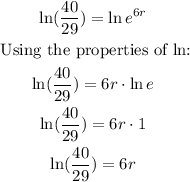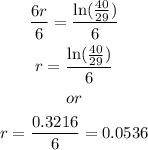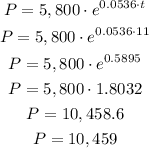This problem asks to:
a) Find a model to predict the population P as a function of t (years since 2011).
b) Predict the population in 2022.
To find this information, follow the steps below.
Step 1: Write a general equation for populational growth.
The population growth can be represented as:

Where:
P is the population in time t;
Po is the initial population;
r is the rate of growth;
t is the time.
Step 2: Write the equation that represents the moose population.
Since the problems aks to evaluate the population from 2011. Use the population in 2011 as the initial population.
Then, P0 = 5,800.

Now, to find r, use the information for 2017.
In 2017,
P = 8,000
t = 6 (2017 - 2011)
Then,

To isolate r, first divide both sides by 5,800:

Take the ln from both sides.

Divide both sides by 6:

So,
(a) The equation that represents the moose population over the years is:

Step 3: Predict the population in 2022.
In 2022,
t = 11 (2022 - 2011).
Then,

(b) The moose population in 2022 will be 10,459.
Answer:
(a)

(b) 10,459.